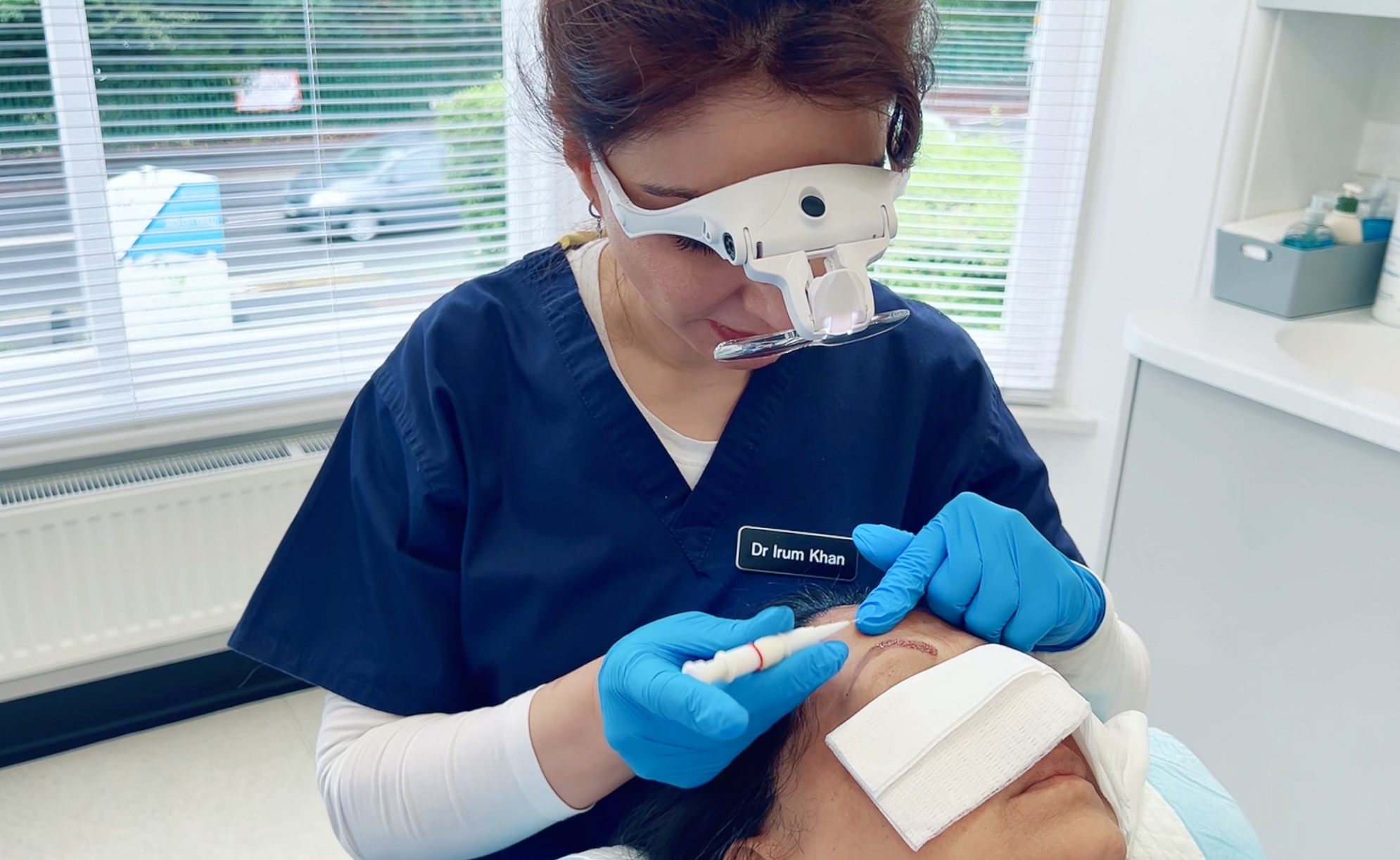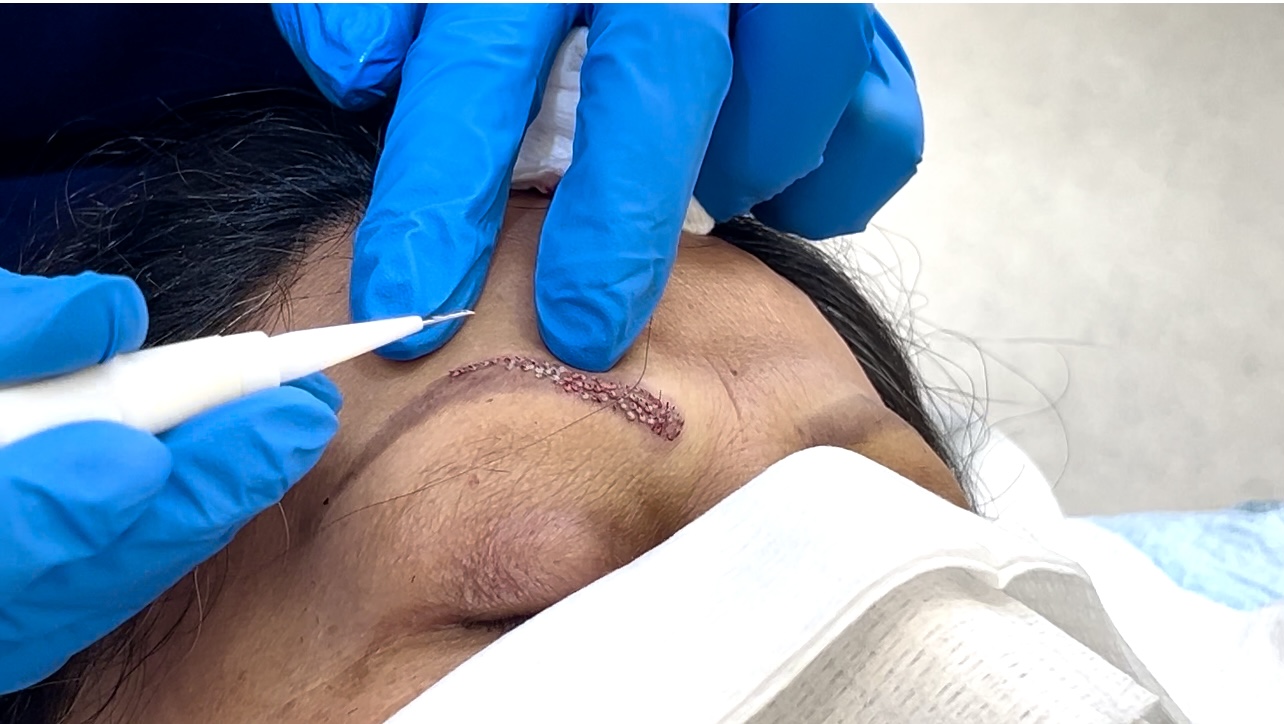Eyebrow hair transplants are increasingly popular as people seek fuller, natural-looking brows. Whether you’ve over-plucked in the past or just want thicker brows, an eyebrow transplant can be a great solution.
This guide covers everything you need to know about eyebrow transplants, from the treatment process to recovery time and aftercare.
What Is an Eyebrow Hair Transplant?
An eyebrow hair transplant is a cosmetic procedure where hair follicles, usually taken from the back of the scalp, are implanted into the eyebrow area to create a fuller look.
Unlike temporary solutions such as eyebrow tattoos or microblading, eyebrow transplants use real hair, which grows naturally and offers a long-lasting result. This procedure is an excellent option for those looking for a permanent solution rather than relying on makeup or other temporary fixes.
People consider eyebrow transplants for various reasons. Some have naturally thin brows, while others may have lost brow hair due to factors like over-plucking, ageing, or medical treatments.
With thicker brows trending, eyebrow transplants provide a realistic and lasting way to achieve fuller, natural-looking brows that enhance facial features.

How the Treatment Is Done
The eyebrow transplant process starts with an initial consultation, where you discuss your desired eyebrow shape, thickness, and overall appearance with a specialist.
This session allows the specialist to assess your current brows, scalp, and hair type to ensure you’re a suitable candidate. The specialist will design a plan tailored to your facial features and desired results.
On the day of the procedure, hair follicles are harvested, typically from the back of your scalp. The number of follicles needed varies based on the fullness you want but usually ranges between 100 and 400 grafts per eyebrow.
Extracting these follicles requires precision to maintain their quality and ensure they’ll grow effectively once implanted in the brow area.
The final step is implanting the follicles into your brows. This process is almost like an art, as the specialist places each follicle at specific angles and directions to mimic the natural flow and shape of eyebrow hair.
This meticulous approach ensures the transplanted hairs blend seamlessly with existing brows, creating a realistic and cohesive look. Overall, the entire process typically takes around two to four hours, depending on the detail and volume desired.
How Long the Process Takes
The eyebrow transplant itself may take only a few hours, but the overall experience, from consultation to visible results, spans several months. Here’s an approximate timeline of what you can expect:
- The initial consultation usually lasts one to two hours.
- On the day of the procedure, you’ll spend about two to four hours undergoing the actual transplant.
- Initial recovery, which involves any visible redness or swelling, typically takes around five to seven days.
- After about three months, you’ll start to see the transplanted hairs growing in, though they may appear sparse at first.
- Full results are usually visible within eight to twelve months after the procedure, giving you a naturally fuller, long-lasting brow.
In many cases, only one transplant session is needed to achieve the desired thickness. However, if a person wants extra volume or definition, they might consider a follow-up session, which can be discussed during follow-up appointments.

Recovery Time and Stages
Recovery from an eyebrow transplant is straightforward, with the initial recovery phase lasting about a week.
During this time, you may notice minor redness, swelling, and small scabs around the implanted follicles. These scabs typically fall off within a few days as part of the healing process.
For the first few days, expect some mild redness and swelling in the brow area, along with small scabs where each follicle was implanted. This is normal and should subside as the scabs naturally shed.
During the first one to two weeks, you might also experience “shock loss,” where some of the transplanted hairs shed. This shedding phase is typical and part of the process.
Around three to four months after the procedure, new hair should start to grow. The initial growth may be sparse but will thicken over time. By six months, you should see significant growth, with fuller brows becoming more noticeable.
The final results, including natural growth and shape, usually appear between eight to twelve months after the procedure.
Aftercare Tips for Best Results
Proper aftercare is essential for the success of your eyebrow transplant. Following the procedure, it’s crucial to avoid touching, scratching, or rubbing your brows for the first week to let the follicles settle securely.
Gentle cleaning, as instructed by your doctor, is recommended. This may involve using a mild cleanser and carefully patting (not rubbing) the brows dry.
For at least a week, avoid applying makeup around your eyebrows to reduce the risk of infection. It’s also wise to stay out of direct sunlight, as excessive exposure can hinder the healing process and cause pigmentation changes in the skin. If you do go outside, wearing a hat or sunglasses can help protect the area.
Vigorous activities that cause sweating, such as exercise, should be avoided for about a week as well. Sweat can irritate the treated area, prolonging recovery. Following these guidelines helps ensure that your transplanted follicles take root and continue to grow healthily.

What to Expect from Your New Brows
Once fully healed, your eyebrow transplant will give you natural-looking brows that grow just like regular hair.
However, since the transplanted hair typically comes from the scalp, it may grow longer than your original brow hair. Regular trimming or professional grooming may be necessary to maintain a neat, natural shape.
Eyebrow transplants offer a long-term solution, and with proper care, the results can last a lifetime. The final look will be uniquely yours, with natural growth patterns that make it hard to distinguish between the original and transplanted hairs.
Is an Eyebrow Transplant Right for You?
Eyebrow transplants can be life-changing for those looking to enhance their brows permanently.
They’re ideal for individuals with thin or sparse brows due to genetics, ageing, or over-plucking. The treatment is also suitable for people who have lost brow hair due to medical conditions or treatments.
However, it’s essential to consult with a qualified specialist, like our team at IK Clinics, to ensure an eyebrow transplant aligns with your expectations and lifestyle.
People with certain skin conditions or a history of poor wound healing should discuss these concerns with their doctor to determine whether they’re suitable candidates for the procedure.
Final Thoughts
Eyebrow hair transplants provide a natural, long-lasting solution for anyone seeking fuller brows.
While the process may seem lengthy, the results are worth it, offering beautifully defined eyebrows that grow like natural hair. If you’re considering an eyebrow transplant, be sure to work with an experienced specialist to ensure the best results.
Embrace the process, follow the aftercare guidelines, and enjoy the confidence boost that comes with beautifully fuller, natural brows! With a bit of patience and care, you can look forward to brows that frame your face with added definition and style.

About IK Clinics
We don’t just specialise in Eyebrow Transplants, we also offer other hair restoration treatments, such as FUE, Stem Cell Therapy, Plasma Therapy (PRP) and Beard Transplants. Additionally, we also provide a range of anti-aging treatments to help you achieve that ‘I feel good’ feeling.
Get in touch to find out more and book your consultation.


